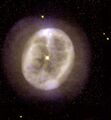Astronomy:NGC 2022
| Emission nebula | |
|---|---|
| Planetary nebula | |
| File:250px | |
| Observation data: J2000 epoch | |
| Right ascension | 05h 42m 06.19056s[2] |
| Declination | +09° 05′ 10.5843″[2] |
| Distance | 8.21 kly (2.518 kpc)[3] ly |
| Apparent magnitude (V) | 11.6[4] |
| Apparent dimensions (V) | 28″[4] |
| Constellation | Orion |
| Physical characteristics | |
| Radius | 0.326 ± 0.039 ly[5] ly |
| Notable features | Double-shell |
| Designations | PK 196-10 1, IRAS 05393+0903[6] |
NGC 2022 is a planetary nebula in the equatorial constellation of Orion, located at a distance of 8.21 kilolight-years from the Sun.[3] It was first observed by William Herschel on December 28, 1785, who described it as: considerably bright, nearly round, like a star with a large diameter, like an ill-defined planetary nebula.[7] In medium-sized amateur telescopes it looks like a small grayish patch of light. It is not very bright but it is still easy to spot it in the eyepiece. Even in a telescope as small as 80mm it can just be seen using a narrowband filter such as an OIII filter as a 'fuzzy' star. The object has the shape of a prolate spheroid with a major to minor axis ratio of 1.2,[4] an apparent size of 28″, and a halo extending out to 40″, which is about the angular diameter of Jupiter as seen from Earth.[8]
This is a double-shell planetary nebula with a wind-compressed inner shell and a more nebulous second shell.[9] The linear radius of the inner shell is estimated at 0.326 ± 0.039 ly. It is expanding with a velocity of 28±2 km/s. The second shell is nearly circular and is expanding more slowly than the inner.[5] The mass of the ionized elements in the planetary nebula is 0.19 M☉, or 19% of the Sun's mass.[5] A faint outer halo consists of the remains of material ejected during the central star's asymptotic giant branch stage.[10]
NGC 2022 lies 11° away from the Galactic Plane, which position suggests it was formed from a low-mass star. The elemental abundances are similar to those in the Sun, although carbon is about 50% higher and sulfur is a factor of two lower.[8] The central star of this nebula has a visual magnitude of 15.92, a temperature of 122,000 K, and is radiating 852 times the luminosity of the Sun from a photosphere that has only 6.55% of the Sun's radius.[8]
Gallery
A Hubble Space Telescope (HST) image of NGC 2022. Credit: HST/NASA/ESA.
References
- ↑ "The Inky Abyss" (in en). https://www.spacetelescope.org/images/potw1932a/.
- ↑ 2.0 2.1 Brown, A. G. A. (August 2018). "Gaia Data Release 2: Summary of the contents and survey properties". Astronomy & Astrophysics 616: A1. doi:10.1051/0004-6361/201833051. Bibcode: 2018A&A...616A...1G. Gaia DR2 record for this source at VizieR.
- ↑ 3.0 3.1 Stanghellini, Letizia et al. (2008), "The Magellanic Cloud Calibration of the Galactic Planetary Nebula Distance Scale", The Astrophysical Journal 689 (1): 194–202, doi:10.1086/592395, Bibcode: 2008ApJ...689..194S.
- ↑ 4.0 4.1 4.2 Finlay, Warren H. (2014), Concise Catalog of Deep-sky Objects, The Patrick Moore Practical Astronomy Series (2nd ed.), Springer Science & Business Media, p. 188, ISBN 978-3-319-03169-9.
- ↑ 5.0 5.1 5.2 Sabbadin, F. et al. (July 1984), "The planetary nebulae NGC 1535 and NGC 2022.", Astronomy and Astrophysics 136: 193–199, Bibcode: 1984A&A...136..193S.
- ↑ "NGC 2022". SIMBAD. Centre de données astronomiques de Strasbourg. http://simbad.u-strasbg.fr/simbad/sim-basic?Ident=NGC+2022.
- ↑ O'Meara, Stephen James (2011), Deep-Sky Companions: The Secret Deep, 4, Cambridge University Press, p. 111, ISBN 9781139500074, https://books.google.com/books?id=v859bKO0A4gC&pg=PA111.
- ↑ 8.0 8.1 8.2 Pottasch, S. R. et al. (June 2005), "Abundances of planetary nebulae NGC 2022, NGC 6818 and IC 4191", Astronomy and Astrophysics 436 (3): 953–965, doi:10.1051/0004-6361:20042627, Bibcode: 2005A&A...436..953P.
- ↑ Kaler, James B., "NGC 2022 in Orion", STARS, http://stars.astro.illinois.edu/sow/n2022.html, retrieved 2020-04-12.
- ↑ Corradi, R. L. M. et al. (April 2003), "Ionized haloes in planetary nebulae: new discoveries, literature compilation and basic statistical properties", Monthly Notices of the Royal Astronomical Society 340 (2): 417–446, doi:10.1046/j.1365-8711.2003.06294.x, Bibcode: 2003MNRAS.340..417C.
External links
 |



